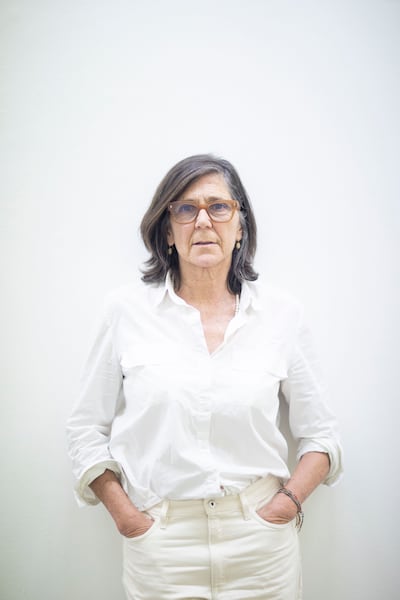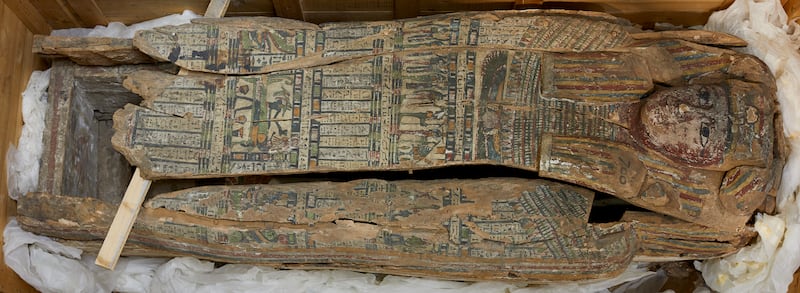It was an August day last year when a coffin was loaded into the hearse by a team of suited undertakers, to travel from Letterfrack, Co Galway to Cork. As people watching asked each other who had died, artist Dorothy Cross - driving behind the hearse - smiled to herself. Inside were the remains of an Egyptian man: about 2,000 years old. The roughly four-hours drive was what Cross hoped would be the beginning of a much longer journey to return the remains home.
When we met last week in the Kerlin Gallery, in central Dublin, what Cross calls the “body” or “mummy” had not moved much further. It is still in Cork. The team involved in what they’ve called the Kinship project hope it will make it to Egypt by the end of the year.
Cross, a 67-year-old originally from Cork but based in Connemara, has been an artist for almost half a century.
In 1999, she created Ghostship, which saw a decommissioned ship covered in phosphorous paint and moored in Dublin Bay. Two decades later, Heartship involved sailing Irish navy ship the LÉ James Joyce up Cork’s river Lee while carrying musician Lisa Hannigan and the remains of a heart wrapped in lead. “It took four years for Heartship to happen because we were searching for a human heart,” Cross recalled. The eventual one they found had been placed in a crypt in the mid-19th century, before making its way to the Pitt Rivers Museum in Oxford, which rented it to Cross.
While Ghostship was more about “nostalgia and life in a risk zone”, drawing from her memories of visiting men working on ships as a child with her father, Heartship made a point about the huge numbers of people drowning in the Mediterranean Sea, she says. The LÉ James Joyce was involved in rescuing 2,491 people from there over three months in 2016, as well as recovering the bodies of 21 others.
After the Heartship project finished, Cross says she remembered that her aunt, May O’Donovan, had told her about an Egyptian mummy in the care of University College Cork (UCC) that was “always trouble”. Cross asked John FitzGerald, who was a UCC librarian, to find out what had happened to it.
It turned out the human remains were being kept in Letterfrack, a short drive from Cross’s home in Connemara, where UCC was paying to keep it in storage. The owner of the restoration and conservation company “pulled this box out and opened the lid and I nearly died,” Cross recalled about her subsequent visit there. “I just said ‘he has to go back’.”
What she saw was “terribly lonely”. Remains covered in “2,000-year-old linen”, with a breastplate and “a long piece of fabric with hieroglyphics”. The man’s face, once they removed the tissue covering it, was “down to the bone”.
For Cross, these remains represented something special because they were not those of a high-ranking person. She said they knew that because of the way he was buried.
Since then, Cross has been working with a team including FitzGerald, Mary Hickson, who curates afestival called Sounds from a Safe Harbour, and Maeve-Ann Austen. “It seems like the story connects to everybody,” Cross said. “I’m very interested in the body. Our own bodies, our own infinite bodies and the fact that we’re all going to die. I can identify with this man ... he was probably around when Jesus was walking on the planet ... It’s about respect for the body and respect for the body postmortem. And our relationship to our own death and how we are disposed of and all that.”

As well as making efforts to return the remains to Egypt, Cross is organising a book related to the project. So far, the writers whom she has signed up to contribute include English artist and author Edmund de Waal, British-Libyan writer Hisham Matar, whose memoir, The Return, is about a search for his political prisoner father and won a Pulitzer Prize, and Egyptian novelist Ahdaf Soueif, who wrote The Map of Love.
Cross said she will also be producing limited edition sculptures and scarves to fund a film documenting the mummified remains being transported.
Last year, the team working on Kinship visited Egypt, making contacts to help with their mission. They went to one newer museum “that looks like an airport meets IKEA”; Cross was relieved that an older one agreed to take the remains instead.
Cross said she met Mostafa Waziry, the secretary general of Egypt’s Supreme Council of Antiquities. “First he said ...‘we don’t want your mummy, we have enough mummies’. Every day they’re finding more tombs in Egypt,” she recalled.
[ Egypt uncovers oldest and ‘most complete’ mummy yet to be foundOpens in new window ]
“I then dived in and started telling him about the reason for the project. About the notion of the body ... disrespectfully being moved and [then] returned to his home ... And he loved that, and he grabbed me by the hand and said ‘we’ll take your mummy’.”
Waziry said the remains would have to be transported by plane, and not on a ship, as Cross had initially envisaged. (Waziry was not reachable for comment for this article).
Cross considered whether it was possible to guild the plane in gold (“Look at what the Egyptians did. The brilliance of their vision,” she said as an explanation). That part of the plan did not go ahead.
A lot of Cross’s work involves combating administrative hurdles. With Ghostship, which took about two years of planning, she describes dealing with the Dublin Port Authority as “tricky” initially, though eventually things came together. “The thing about these things: really they’re very simple but they become so complex ... everybody becomes hysterical.”
Heartship took four years to arrange, and Kinship has taken four years so far, she said. “This one really has taken me over, ... I’ve become very obsessed with it.” But she said that recently “I’ve decided I need to let it go a little bit and let it happen. Because you can’t control everything”.
John FitzGerald, who was until recently UCC’s director of information services, as well as being a librarian, said by email that a legal agreement is being prepared. When it is finalised and signed, an export licence will have to be approved by the Irish Department of Tourism, Culture, Arts, Gaeltacht, Sport and Media. “In the meantime, we are carrying out conservation work needed to ensure safe transit of the items. This work is being done by a professional conservator based at UCC,” said FitzGerald. “All going well with the contract and export licence, we’re hoping to bring the collection to Cairo in October or November of this year.”
He said that the mummified remains were originally given to the university in 1928 by the Society of African Missions (SMA), which had a base in Cork.
“We don’t know how or why the remains came to Ireland, but it was not uncommon for items like this to circulate outside Egypt at the time,” said FitzGerald. “Research has indicated that there was a practise in the Cairo Museum, run by the Service des Antiquités, of selling antiquities from the 1890s to the 1970s through the Sale Room, or Salle de Vente, in the museum building. This could have been the route taken, however we have no information about the reason why the remains arrived at the SMA house in Cork.”
After that, he said, it became “part of a classical Egyptian collection established by the university in the late19th century for exhibition and to support its teaching in classical studies”.
Last year, UCC agreed to donate some of the items in the collection back to Egypt, including the mummified remains, along with “a sarcophagus, four Canopic jars and some items of cartonnage [covering],” FitzGerald said.

He said the donation is being facilitated by officials in the Egyptian embassy in Dublin.
A spokesperson for the Irish Department of Foreign Affairs said it is “supporting Kinship as a unique and artistically compelling project of the highest ambition, exploring shared history, commissioning contemporary creative responses and deepening Irish-Egyptian cultural and institutional relationships”. The spokesperson said €50,000 of funding is being provided.
Cross’s goal with the project, she said, is to “make people conscious of the notion of bodies disappearing or being removed ... our relationship to our own bodies”. She said it is about “re-grounding us in terms of our body but then accessing something that’s greater than ourselves”.
I asked her whether there was any broader geopolitical point in terms of anything happening in the current day, for example people being killed but not identified in the current conflicts in Ukraine or Sudan. “People being identified from their burnt bones in Ukraine or wherever else is very relevant because it’s another human being,” she said.
Cross said she occasionally questions the value of art, when compared - for example - with reporting done from the ground during crisis situations. “I despair sometimes making visual art because you think is it only reaching very, very few people?” she explained. “But there is something about a resonance that can move through the earth. I do believe that there is a certain amount of power ... If it actually stops you even for a second in terms of consciousness, then it’s successful.”












